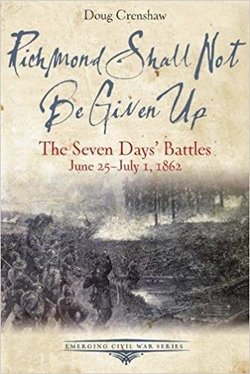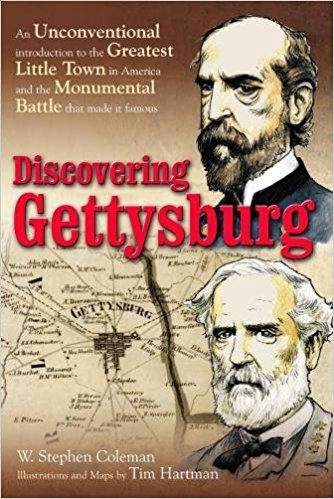
Doug Crenshaw
Savas Beatie, 2017, 192 pp., $14.95
ISBN: 978-1-61121-355-3
Image courtesy of amazon.com
The Emerging Civil War Series has introduced many readers across the country to specific cites of the American Civil War. For all of the writing which has been done, I was surprised that the Seven Day’s Battles had not yet been covered. Thanks to Doug Crenshaw, Richmond Shall Not Be Given Up is the book from that series which strives to bring an introductory treatment to the Seven Day’s Battles. Personally, I don’t think those battles get enough attention as it is, but that is only myself as a Civil War reader. While we focus greatly on the Battles of Antietam and Second Manassas, this book gives us some much needed information regarding the actions between the dates of June 25 to July 1, 1862
Doug Crenshaw is a volunteer historic interpreter at the Richmond National Battlefield Park. As a member of the Richmond Civil War Roundtable, Doug is a speaker, presenter, tour guide, and author of books on both Glendale and Fort Harrison. He is a descendant of the Sydnor family from Beaver Dam Creek during that battle, and the Binford family, who lived in the area of Malvern Hill. He has also written Fort Harrison and the Battle of Chaffin’s Farm, and The Battle of Glendale: Robert E. Lee’s Lost Opportunity.
As it is with all of the Emerging Civil War Series books, there is great appreciation for the photographs, maps, and even drawings placed on every page. As an introductory to these engagements, they are greatly needed for those who know little. For myself, one of the most interesting parts about the Seven Day’s Battles as a whole was when Lee took command before the conflicts. That portion of the work was handled quite well as the narrative places a great emphasis on his leadership. The other portion which was also handled well was the subject of General McClellan and how his own ego would be bruised in these fights. In my own personal studies, I have found many mentions of the Seven Days Battles and I enjoyed the narrative and explanations of them more so than other parts of the book. I felt that the narrative written by Crenshaw brought more light to the subject at hand. As usual in the Emerging Civil War Series, there are appendices which fall into the book, only three for this installment, and also driving instructions for the reader if they were to take this volume with them to the battlefield.
Once again, the Emerging Civil War Series hits it out of the park with this one. I highly recommend this book to students who wish to gain a deeper understanding of the Seven Day’s Battles and the events which would lead the fall of 1862. There are not enough books about these engagements and I thank Crenshaw for bringing this introductory study to light here. After reading this book, I know I will personally seek out his other works on these conflicts, hoping to gain a deeper understanding myself. Highly Recommended!

 RSS Feed
RSS Feed
